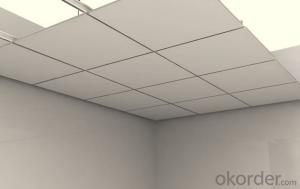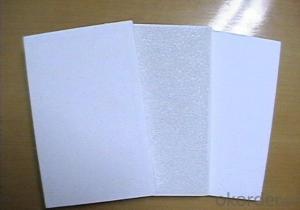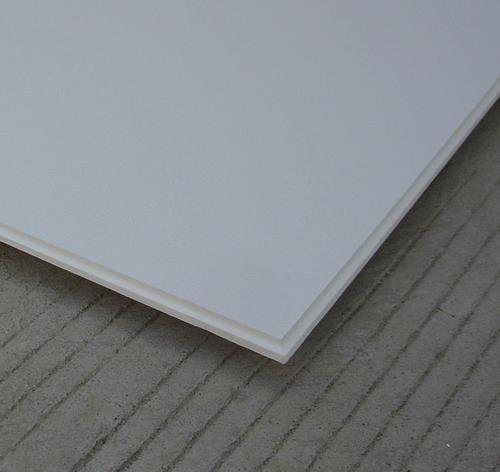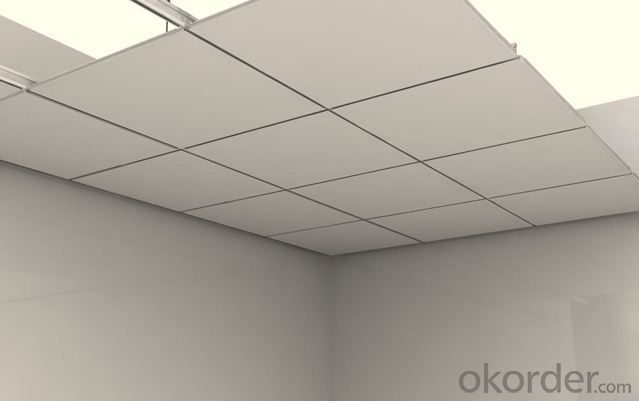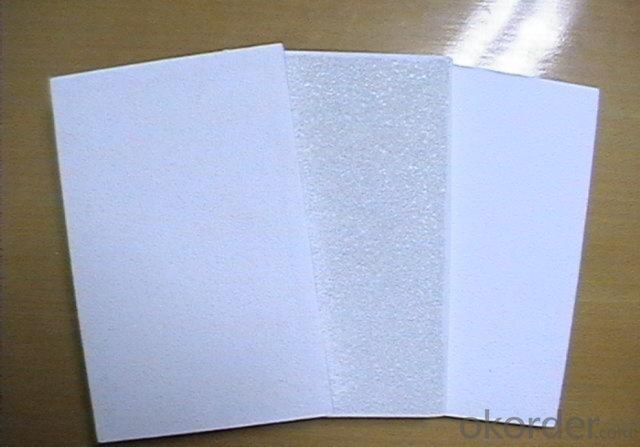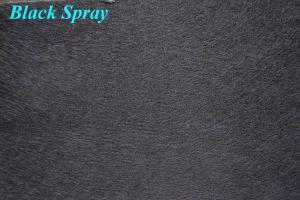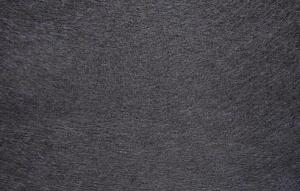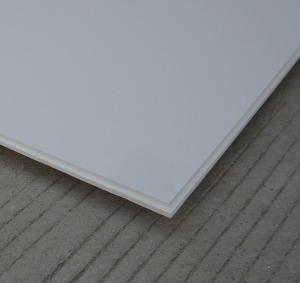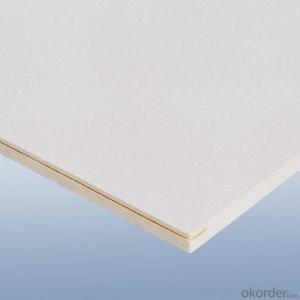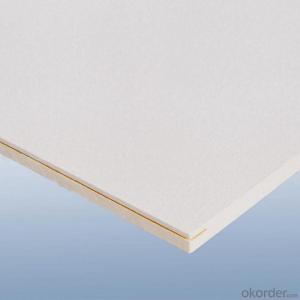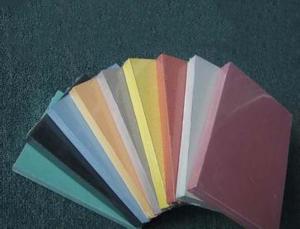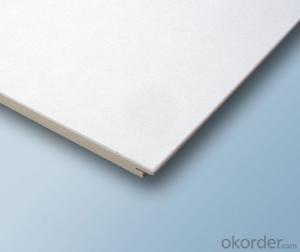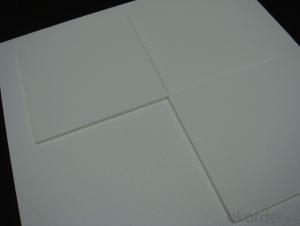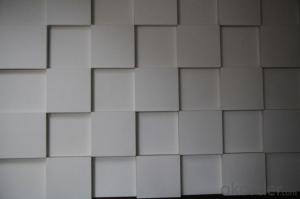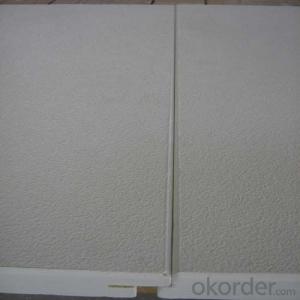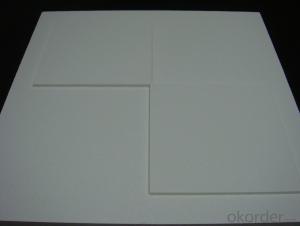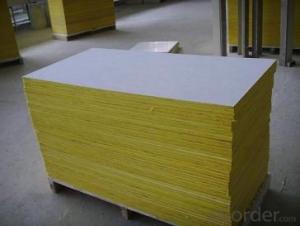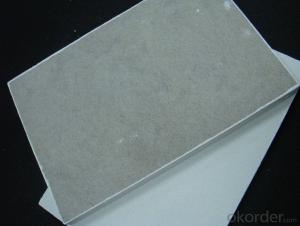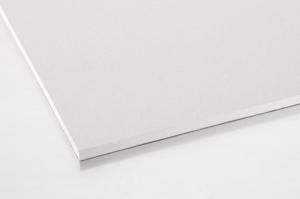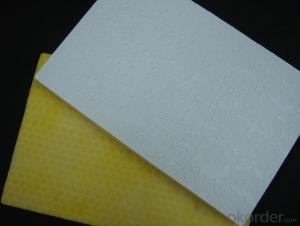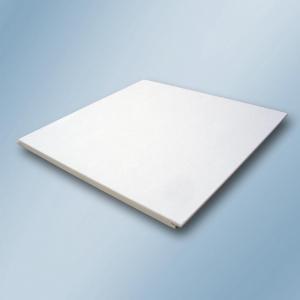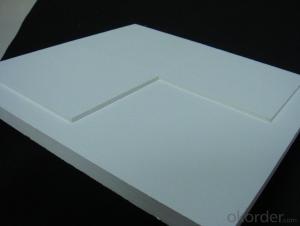12mm Thick Straight Fiberglass Ceiling Baffles - Hot Sale
- Loading Port:
- Shanghai
- Payment Terms:
- TT OR LC
- Min Order Qty:
- 4000 m²
- Supply Capability:
- 50000 m²/month
OKorder Service Pledge
OKorder Financial Service
You Might Also Like
The tiles are manufactured from high density fiberglass wool.The visible face has a decorative fiberglass tissue and the back of the tile is covered with normal tissue.The four edges of the tile are sealed and have grooves. It can be jointed together without suspended system. The tiles will cover the suspension system after installation. They are are suitable for loe flap ceiling space and concrete-made, wooded-made or gymsum ceiling.
Installation method:
Use screw to fix the smooth roof. The tiles can be connected after making grooves on each two jointed edges.
Tiles are easy to trim and install
Both inches and metric grids are available
Main Characteristic:
Non-combustible
No sagging,wrapping or delaminating
Green building material
Excellent sound absorption
Application:
Halls,classrooms,offices,shopping centers.etc.
Acoustic fiberglass ceiling contains a better perfomance in tension strong, light weight, so it is easy to trim and install for interior decoration, with T-grids for suspension system or glue, nail or good material could come with fiberglass ceiling baord. Thus an excellent artical work need a high quality acoustic ceiling board, also high quality.
Energysaving is a trend for our 21' era, new product like fiberglass ceiling tile could in place of traditional products one day. Which depends on functional characters: little deflection of geometry dimention, no radiocative property, specific activity of 226Ra: Ira ≤1.0 and specific activity of 226 Ra 232 Th, 40 K: Ir ≤ 1.3. Both products and packages can be recycled.
- Q: My house has not been renovated, according to the upstairs that he bought the best waterproof glue, do a number of waterproof treatment, try to see the water did not see a leak, told me to be assured! What is the possibility of future leakage? Thank you
- No matter he did not do waterproof, first told him to plug the hole, and looked uncomfortable. It is recommended to plug Wang Wang waterproofing agent mix a little sand, the effect is particularly good. Followed by good water, must be sure to personally do not leak, the best with the property management to participate in the acceptance, because the problem, property management and even the relationship. Tell the truth to see that hole, I doubt they can do waterproof.
- Q: I bought a new house is the top floor, not submitted to find the top (rooftop) on the cracks, I would like to ask such a house qualified? Will it be leaking later?
- This is not seen above the cement brick ah, in addition, if there is no impact on the protective layer cracks, many of which are to be slit, and more information, better advice, free waterproof concrete waterproof repair professional technical advice , Exempt from today's repair, tomorrow leak; yearly repair, year-old trouble
- Q: My house from 2009 to 2017, upstairs two households turn water seepage, resulting in my house has watermark, and moldy black phenomenon, and now need to refurbish the processing, because the region is easy to resurgence in the winter, so need Heroes who help out, talk about my house need to brush a few layers, respectively, need to brush what paint, the more specific the better
- First of all, you have to according to your region's perennial situation, when the most dry, then arranged at this time to start the project. Second, in the moldy and black place from the surface began to eradicate, if the putty layer is better, you can not shovel, if the putty layer is loose, it is recommended to eradicate, shovel to the cement mortar surface. And then start from the mortar side putty putty, putty dry, sand skin leveling, on the paint, the general family indoor paint can be two, if you do not think it, then 3-4 times. Paint no special requirements, because they live in the inside, so use no taste or no formaldehyde, benzene paint, the price is slightly more expensive, the specific is not recommended.
- Q: It is best not to affect the decoration, the project is small, but can not be long-term to the downstairs leaking, the cause of the water may be the original decoration is not good, the last time to replace the angle valve to solve, but hope that the future no longer encounter water leakage. Do not drip, just seepage to the ceiling of the downstairs, self-house cabinets near the base line of the external paint is also mottled, downstairs ceiling also paint mottled (the room other walls or ceilings do not leak the place did not this problem). It is best not to affect the decoration, the project is small, but can not be long-term to the downstairs leaking, the cause of the water may be the original decoration is not good, the last time to replace the angle valve to solve, but hope that the future no longer encounter water leakage.
- If it is really a waterproof layer of the problem, you can get their own, I was in OKorder to buy their own leak to stop to fill, buy the kind of emulsion, the construction is too convenient, the material leaching to the place on the line, you You can try to see, please people too expensive, but also uncertain to solve the problem.
- Q: Properties of thermoplastic composites
- The thermoplastic resin matrix composites were developed in the 1980s, mainly including long fiber reinforced pellets (LFP), continuous fiber reinforced prepreg (MITT) and glass fiber felt reinforced thermoplastic composites (GMT). According to the different requirements, the resin matrix mainly PP, PE, PA, PBT, PEI, PC, PES, PEEK, PI, PAI and other thermoplastic engineering plastics, fiber types include glass fiber, carbon fiber, aramid fiber and boron fiber and all possible Of the fiber varieties. With the thermoplastic resin-based composite technology continues to mature and recyclable advantages, the varieties of composite materials developed rapidly, Europe and the United States developed thermoplastic resin matrix composite materials have accounted for more than 30% of the total amount of resin-based composites. ?High-performance thermoplastic resin-based composite materials to the majority of injection, the base to PP, PA-based. Products are pipe fittings (elbows, tees, flanges), valves, impellers, bearings, electrical and automotive parts, extrusion molding pipes, GMT molded products (such as jeep seat supports), car pedals, seats and so on. The application of glass fiber reinforced polypropylene in automobiles includes ventilation and heating systems, air filter housings, gearbox covers, seat frames, fender pads, and transmission belt covers.
- Q: We have an area in our ceiling that had water damage a few years ago and we repaired it ourselves for a quick fix. We never got around to actually getting it professionally repaired, but had never had any issues so it wasn't something we were worried about. About 3 days ago we noticed that there was a hole, about an inch long, I'm the crease of the ceiling where it meets the wall in the same place we had repaired. We don't know if maybe there is a mouse in the wall chewing a hole, if the house finally settled to the point where it cracked our repair job, or if there is another answer. It appears that the holes are only in the drywall tape and not in the drywall itself. Does anyone have any suggestions on what could be going on our who we could call in to inspect this?
- Could be the mold, but simply could be the tape deteriorating. Did you use paper tape? IF you fix it again, use the self stick fiberglass tape before you mud over it.
- Q: I was replacing a bathroom fan and the new bathroom fan is bigger than the old one. I took out the old one. Then I used a pencil and traced around the new fan. Then I used a reciprocating saw for the first time and got a little crazy with it. Now the hole is slightly too big and when I put the grill cover on the fan, I can see the hole. I'm not sure what to do now. I still got old pieces of the ceiling. Maybe I can do something with it?
- It sounds like when you put the fan in you can see holes around it. If that is correct then get some cardboard and wrap around the fan two or three times around the fan where it fits through the hole. So later when it is removed it give the correct gap around the fan fit to the hole.Now you should be able to secure the fan in place but not up tight to the roof, so you can still get plaster into the gap. Then get some plaster filler. you can get it from hardware store. And with a scraper that is used for plaster fill the gap. Let it dry. You then take the fan out and then remove the cardboard and discard. With the cardboard out their should be just the right amount of gap for the fan to fit back in snuggle and perfect. Use just enough cardboard as you think will do the job. The plaster also sticks to the card board and not the fan housing. You can also rap some Glad Wrap around the cardboard on the out side and it will pull away from the plaster easier when it is dry.Then sand, then you may need that repair with the fiber netting that sticks to it, to strengthen the around the hole. ( buy from hardware. just ask them and they will know. ) stick some of that on to strengthen it and put more plaster on. Let dry, sand and paint. If you google wall plastering repairs you should be able to get some demonstration on how to repair walls with holes so it will show you how to use the mesh to repair. It is not really very difficult. Good luck.
- Q: What is the difference between PVC and nylon?
- First, PVC: chemical name PVC, sub-rigid polyvinyl chloride and soft polyvinyl chloride. High mechanical strength, chemical properties of vinyl chloride (code-named PVC) is a vinyl chloride monomer polymerization from the synthetic polymer. Polyvinyl chloride is a white or light yellow powder resin, the density of about 1.4, chlorine content of 56% to 58%. In the polyvinyl chloride resin by adding different plasticizers and stabilizers, can be made of different rigid polyvinyl chloride and soft polyvinyl chloride. Polyvinyl chloride itself is a linear polymer, because the attraction between the molecules is very large, combined with each other close and solid, making the polymer chain is not free, so hard texture. When the resin is not added or less (10% or less) plasticizer, get the hard PVC. Hard PVC high density, with acid, alkali and corrosion resistance of the excellent performance, it is often used as chemical equipment, pipe and construction panels, such as flooring, ceiling and so on. When adding more plasticizer in the resin, you can get soft polyvinyl chloride, plasticizer plus more, the more flexible the plastic. Soft PVC with flexibility, resistance to folding, light, water, oxidation resistance, it is often used to make thin film and wire foreskin and so on. Most of the PVC products in daily life are soft polyvinyl chloride, such as PVC made of leather widely used in clothing, footwear, suitcases, purses and so on. If you add a blowing agent to the polyvinyl chloride plastic, you can make the foam. It has a light weight, thermal insulation, noise and other excellent performance, widely used in footwear, building materials, ship and aircraft manufacturing and other industries.
- Q: Not sure how to spell something that sounds like "ah-spec-tice" please tell me where I can get into on aspectice.
- I know this was posted awhile ago, but I thought this info I got from an expert may be helpful. If your house is built before 1978 it may have asbestos. To remove popcorn ceilings before this date the cheap way is to layer plastic everywhere in the area of the popcorn ceiling use a spray bottle or mister keeping it wet then scrape it off. When finished gather the plastic up keeping the popcorn ceiling remains encased in the plastic put it in a large garbage bag, seal up, and toss it. The key is to keep it wet when removing. For extra precaution wear safety glasses and mask. As long as it's wet it can't be inhaled and that's when it's dangerous. If you think it may be in the walls it's a good idea to get your home tested for the professionals to come in to clean it but it will cost you a lot of money.
Send your message to us
12mm Thick Straight Fiberglass Ceiling Baffles - Hot Sale
- Loading Port:
- Shanghai
- Payment Terms:
- TT OR LC
- Min Order Qty:
- 4000 m²
- Supply Capability:
- 50000 m²/month
OKorder Service Pledge
OKorder Financial Service
Similar products
Hot products
Hot Searches
Related keywords

